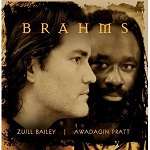|
Back
03/29/2011
Johannes Brahms: Sonata No. 1 in E Minor, Op. 38 – Sonatensatz – Sonata No. 2 in F Major, Op. 99 – Lerchengesang, Op. 70, No. 2 – Feldeinsamkeit, Op. 86, No. 2 – Wie Melodien, Op. 105, No. 1 – Sapphische Ode, Op. 94, No. 4 – Liebestreu, Op. 3, No. 1 – Minnelied, Op.71, No. 5 – Wiegenlied, Op. 49, No. 4
Zuill Bailey (Cello), Awadagin Pratt (Piano)
Recorded Oberlin Conservatory of Music, Clonick Hall, Oberlin, Ohio (September, 2010) – 76’51
Telarc Reference # Tel-32664-02 – English language booklet

This new disc of works by Brahms for cello and piano has been getting some excellent advance press, and for very good reason. This is a terrific set, and shouldn’t be missed. Both musicians here, Zuill Bailey with his interesting extra-musical career on television’s OZ and Awadagin Pratt, with his dreads and smart-guy glasses, are formidable representatives of a younger, ”hipper” generation of interpreters, both among the finest that the American conservatory system can offer, and both impressive academics in their own right, Bailey as Professor of Cello at the University of Texas, Pratt (a triple threat at the Peabody Conservatory, earning diplomas in piano, violin, and conducting) as Associate Professor of Piano at the Conservatory of Music at the University of Cincinnati.
The CD is grounded by two major Sonatas, composed some years apart and easily reflecting the breadth of the composer’s inspiration, the first exploring the lower “voice” of the cello, the second catapulting the instrument into soprano territory. The Sonata in E Minor, Op. 38 is given an impressively expansive performance here by both artists, though I rather prefer the more visceral virtuosity of the second, the Sonata in F Major Op 99, the cello and piano here dueling brilliantly, with some notably exciting playing from Pratt in the dazzling scherzo.
There are seven of Brahm’s most beautiful vocal pieces included, with cello replacing voice, and these interestingly may be the most enjoyable tracks on the CD. I was immediately reminded of a young contralto I once interviewed, who had studied cello before turning to voice, and who related that when she was having trouble capturing the line of a piece, she would play it through on the stringed instrument as a way of internalizing its cantabile before taking it on vocally. Such are the selections here, the opening Lerhengesangparticularly beautiful in its wistful melancholy. The pair’s take on Feldeinsamkeit is excellent.
The disc closes with a liltingly lulling rendering of the thrice familiar Wiedgenlied which emerges as more the gentle lullaby than do so many of the vocal renditions for which it is originally intended. (Happily, I am in the middle of making a compilation of soothing classics for a child in my family, and this is going on there pronto).
Telarc’s recorded sound is crisp and clear without too much reverb (the disc is reportedly the first to be recorded at Oberlin’s new technical top drawer facility). The microphones captured a fair amount of breathing, and there is a chair creak or two; none of which disturbs in the least as I find such things humanize what can potentially be a sterile studio ambiance – some will feel differently about that. The English-only booklet is a bit spare, but is attractive and well considered, and offers an effective historical overview of the works contained as well as decent biographies of the artists. I love the back photo, with the composer looking intensely over the heads of the two performers in what appears to be a wash of rain. In short, this new disc is very well presented, beautifully performed, and should be a welcome addition to any Brahms library. Those who love this repertory should be well pleased.
Mark Thomas Ketterson
|